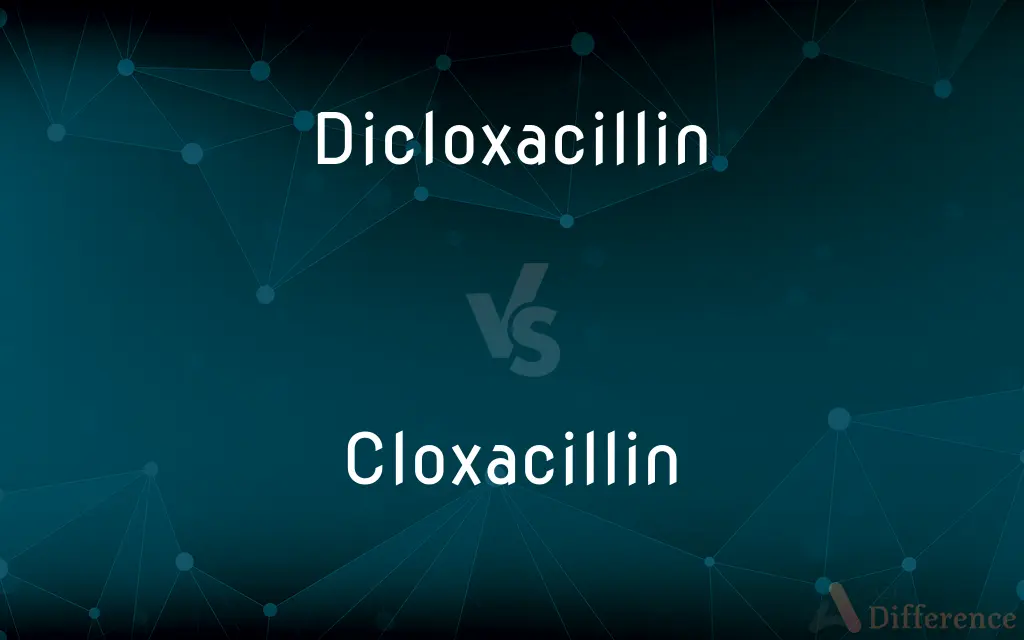Dicloxacillin vs. Cloxacillin — What's the Difference?
By Maham Liaqat & Fiza Rafique — Updated on March 26, 2024
Dicloxacillin is a narrow-spectrum antibiotic targeting penicillin-resistant bacteria, whereas cloxacillin is similar but used in different infections.

Difference Between Dicloxacillin and Cloxacillin
Table of Contents
ADVERTISEMENT
Key Differences
Dicloxacillin is a beta-lactam antibiotic primarily used to treat penicillin-resistant Staphylococcal infections, offering a potent solution against bacteria producing beta-lactamase. Cloxacillin, on the other hand, serves a similar purpose but may differ in its absorption and distribution characteristics, making it suitable for different types of infections.
Both dicloxacillin and cloxacillin are part of the penicillinase-resistant antibiotics group, designed to combat beta-lactamase-producing bacteria. However, dicloxacillin might be preferred in scenarios where higher tissue penetration is required, whereas cloxacillin might be chosen for its efficacy in treating specific types of infections.
Regarding oral bioavailability, dicloxacillin tends to have a slightly higher absorption rate compared to cloxacillin. This difference affects their dosing and effectiveness in treating infections, with dicloxacillin potentially offering a more consistent therapeutic level in the bloodstream.
Dicloxacillin and cloxacillin have similar side effect profiles, including possible allergic reactions, gastrointestinal disturbances, and liver enzyme elevations. Nonetheless, the choice between them may depend on patient-specific factors such as drug allergies, previous medical history, and the infection's location.
The decision to use dicloxacillin versus cloxacillin often comes down to the specific bacterial infection being treated, the patient's medical history, and potential drug interactions. While both antibiotics are effective against penicillin-resistant Staphylococcus, the choice may also be influenced by the healthcare provider's experience and the local bacteria resistance patterns.
ADVERTISEMENT
Comparison Chart
Spectrum
Narrow, against penicillin-resistant bacteria
Similar, with slight differences in bacterial coverage
Absorption
Slightly higher oral bioavailability
Lower oral bioavailability
Distribution
Better tissue penetration for certain infections
Effective for specific types of infections
Side Effects
Allergic reactions, GI disturbances, liver enzyme elevation
Similar side effect profile
Usage
Preferred for infections requiring high tissue penetration
Chosen based on efficacy for specific infections
Compare with Definitions
Dicloxacillin
Effective against penicillin-resistant Staphylococcal infections.
Dicloxacillin is prescribed for cellulitis caused by resistant bacteria.
Cloxacillin
Used for infections caused by penicillinase-producing Staphylococci.
Cloxacillin treats osteomyelitis caused by Staphylococcus aureus.
Dicloxacillin
Used in specific bacterial infections where high tissue penetration is necessary.
Dicloxacillin is chosen for certain types of pneumonia.
Cloxacillin
Selected based on its effectiveness for particular infections.
Cloxacillin is effective against certain types of mastitis.
Dicloxacillin
High absorption when taken orally.
Dicloxacillin achieves effective levels in the bloodstream when administered orally.
Cloxacillin
Chosen for its action against specific strains of bacteria.
Cloxacillin is used in cases where the bacteria have been identified as susceptible.
Dicloxacillin
Good penetration into infected tissues.
Dicloxacillin is effective for deep skin infections.
Cloxacillin
Absorbed at a lower rate compared to dicloxacillin.
Cloxacillin requires careful dosing to achieve therapeutic levels.
Dicloxacillin
May cause gastrointestinal disturbances and allergic reactions.
Some patients on dicloxacillin report nausea and rash.
Cloxacillin
Similar to dicloxacillin, includes possible liver enzyme elevation.
Monitoring is recommended for long-term cloxacillin therapy.
Dicloxacillin
(pharmaceutical drug) A narrow-spectrum beta-lactam antibiotic of the penicillin class, used in the form of its hydrated sodium salt C19H16Cl2N3NaO5S·H2O especially against beta-lactamase producing staphylococci.
Cloxacillin
Cloxacillin is an antibiotic useful for the treatment of a number of bacterial infections. This includes impetigo, cellulitis, pneumonia, septic arthritis, and otitis externa.
Dicloxacillin
Dicloxacillin is a narrow-spectrum β-lactam antibiotic of the penicillin class. It is used to treat infections caused by susceptible (non-resistant) Gram-positive bacteria.
Cloxacillin
A semisynthetic penicillin, C19H18ClN3O5S, that is resistant to penicillinase, used in the form of its sodium salt primarily to treat infections caused by penicillinase-producing staphylococcus bacteria.
Dicloxacillin
A semisynthetic penicillin, C19H17Cl2N3O5S, that is resistant to penicillinase, used in the form of its sodium salt primarily to treat infections caused by penicillinase-producing staphylococcus bacteria.
Cloxacillin
(pharmaceutical drug) A semisynthetic antibiotic C19H18ClN3O5S in the same class as penicillin, effective especially against staphylococci which secrete beta-lactamase.
Dicloxacillin
Antibacterial (trade name Dynapen) used to treat staphylococcal infections that are resistant to penicillin
Common Curiosities
What is dicloxacillin used for?
Dicloxacillin is used to treat infections caused by penicillin-resistant Staphylococci, such as cellulitis and pneumonia.
Can I take dicloxacillin if I'm allergic to penicillin?
Patients with a known penicillin allergy should avoid taking dicloxacillin, as it may trigger an allergic reaction.
What are the side effects of dicloxacillin?
Side effects can include allergic reactions, gastrointestinal disturbances, and liver enzyme elevations.
Is cloxacillin effective against all types of bacteria?
Cloxacillin is specifically effective against penicillinase-producing Staphylococcus bacteria and may not be effective against other types of bacteria.
Is there a difference in the dosage of dicloxacillin and cloxacillin?
Yes, the dosage may differ based on their absorption rates, the infection being treated, and the patient's condition.
Can dicloxacillin treat MRSA infections?
Dicloxacillin is not typically used to treat MRSA infections due to resistance patterns.
How long does it take for cloxacillin to work?
The effectiveness and timing depend on the type of infection, but some improvement is usually seen within 48 to 72 hours.
Should I take dicloxacillin with food?
Dicloxacillin can be taken with or without food, but taking it on an empty stomach may enhance its absorption.
How does cloxacillin work?
Cloxacillin works by inhibiting the cell wall synthesis of bacteria, particularly those that produce penicillinase, making it effective against certain Staphylococcus infections.
How should dicloxacillin be stored?
Dicloxacillin should be stored at room temperature, away from moisture and light.
Can I drink alcohol while taking cloxacillin?
Alcohol may increase the risk of liver side effects and should be avoided or minimized during treatment.
Is cloxacillin safe during pregnancy?
Cloxacillin should only be used during pregnancy if clearly needed and directed by a healthcare provider.
What's the difference between dicloxacillin and amoxicillin?
Dicloxacillin is specifically effective against penicillin-resistant Staphylococcus, whereas amoxicillin has a broader spectrum but is susceptible to destruction by beta-lactamase enzymes.
Can dicloxacillin cause yeast infections?
Like other antibiotics, dicloxacillin may disrupt the normal flora, potentially leading to yeast infections.
Can cloxacillin treat dental infections?
Cloxacillin may be used for dental infections caused by susceptible strains of bacteria, depending on the specific circumstances and bacterial culture results.
Share Your Discovery

Previous Comparison
Rakia vs. Rakija
Next Comparison
Rhomb vs. DiamondAuthor Spotlight
Written by
Maham LiaqatCo-written by
Fiza RafiqueFiza Rafique is a skilled content writer at AskDifference.com, where she meticulously refines and enhances written pieces. Drawing from her vast editorial expertise, Fiza ensures clarity, accuracy, and precision in every article. Passionate about language, she continually seeks to elevate the quality of content for readers worldwide.













































